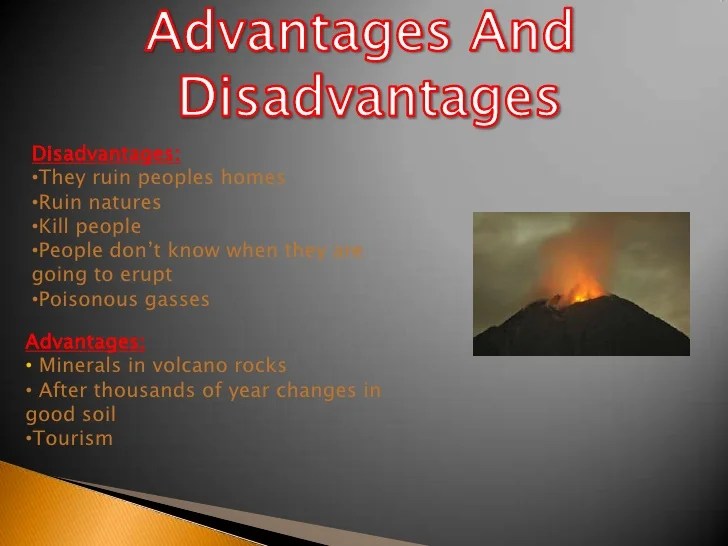Volcanoes, with their fiery eruptions and towering presence, have long fascinated and terrified humanity. They are both a source of awe and a reminder of nature’s raw power. In this article, we delve into the pros and cons of volcanoes, exploring their benefits and drawbacks, and the challenges they pose to human societies.
From their role in nutrient cycling to the creation of new landmasses, volcanoes have played a significant role in shaping our planet. However, their destructive eruptions can cause widespread devastation, affecting air quality, climate, and human infrastructure.
Introduction: Pros And Cons Of Volcanoes
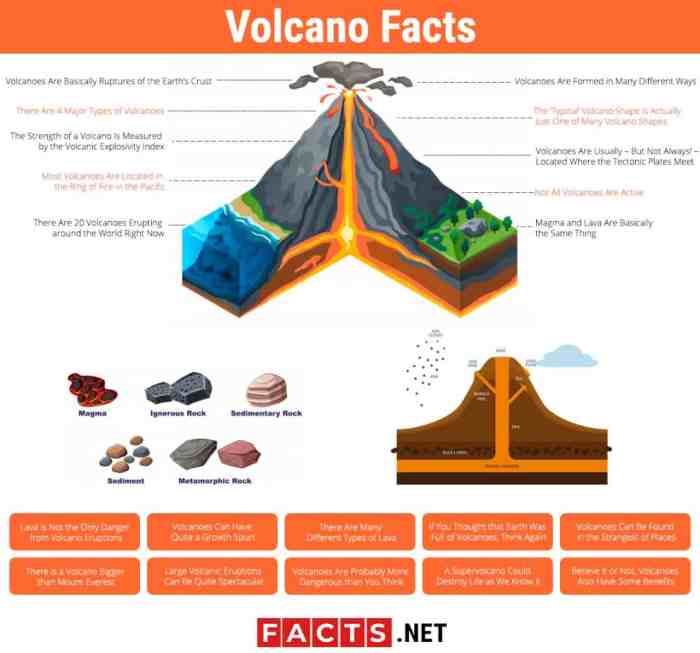
Volcanoes are fascinating geological formations that have shaped the Earth’s surface for millions of years. They are essentially mountains or hills with an opening or vent at the top that allows molten rock, ash, and gases to escape from deep within the Earth.
Volcanoes are formed when magma, the molten rock beneath the Earth’s crust, rises towards the surface and accumulates in a chamber or reservoir. If the pressure within the chamber becomes too great, the magma erupts through a vent or fissure in the Earth’s surface, creating a volcano.
Types of Volcanoes
There are various types of volcanoes, each with distinct characteristics and behaviors. Some of the most common types include:
- Cinder Cone Volcanoes:These are small, steep-sided volcanoes composed of loose cinders and ash. They are typically formed during short-lived, explosive eruptions.
- Shield Volcanoes:These are broad, gently sloping volcanoes with a low profile. They are formed by the eruption of low-viscosity lava that flows easily, creating a shield-like shape.
- Composite Volcanoes:Also known as stratovolcanoes, these are tall, conical volcanoes with alternating layers of lava and ash. They are characterized by explosive eruptions that produce both lava flows and ash clouds.
- Caldera Volcanoes:These are large, basin-shaped depressions formed when a volcano collapses after a major eruption. They are often filled with water, creating volcanic lakes or calderas.
Benefits of Volcanoes
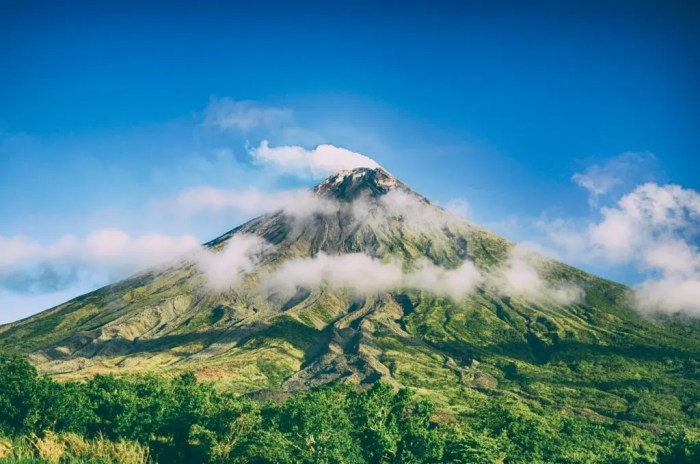
Volcanoes, often associated with destruction and devastation, also offer a range of benefits that contribute to the planet’s ecosystems and human societies.
Nutrient Cycling
Volcanic eruptions release a wealth of minerals and nutrients into the surrounding environment. Ash and lava, rich in elements such as potassium, phosphorus, and nitrogen, enhance soil fertility and promote plant growth. This nutrient-rich soil supports diverse ecosystems and contributes to global food production.
Landmass Formation and Habitats
Volcanic eruptions can create new landmasses and expand existing ones. Lava flows and ash deposits accumulate over time, forming islands, peninsulas, and mountains. These newly formed landmasses provide habitats for various species, expanding biodiversity and creating unique ecosystems.
Geothermal Energy and Resources
Volcanic activity often generates geothermal energy, a renewable source of heat and electricity. Geothermal power plants utilize the heat from underground volcanic reservoirs to produce electricity or heat homes and businesses. Additionally, volcanoes can be a source of valuable minerals, such as sulfur, copper, and gold, which are extracted for industrial and commercial use.
Drawbacks of Volcanoes
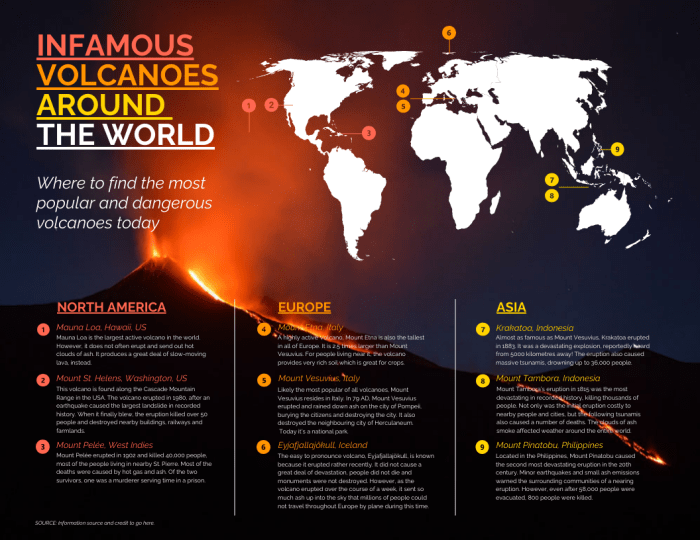
Volcanoes, while awe-inspiring natural wonders, also possess a destructive force that can wreak havoc on ecosystems and human populations. Their eruptions can unleash a torrent of molten rock, ash, and gases that devastate landscapes and threaten lives.
Lava Flows
Lava flows, rivers of incandescent molten rock, are a primary hazard associated with volcanic eruptions. As they surge down the volcano’s slopes, they incinerate everything in their path, destroying vegetation, infrastructure, and entire communities. The intense heat and speed of the lava make it virtually impossible to contain or divert, often resulting in catastrophic damage.
Ash Clouds
Volcanic eruptions can also produce vast clouds of ash that spread far and wide. These ash clouds can disrupt air travel, grounding flights and causing widespread delays. The ash particles can also irritate respiratory systems, leading to health problems for vulnerable individuals.
In extreme cases, ash clouds can collapse roofs and block roads, cutting off access to essential services.
Volcanoes, while destructive, also offer benefits like fertile soil and geothermal energy. Just like how upper bound at a bank nyt ( upper bound at a bank nyt ) sets a limit on spending, volcanoes have their own pros and cons that shape our understanding of their impact.
Pyroclastic Flows
Pyroclastic flows are fast-moving clouds of hot gas, ash, and volcanic fragments that race down the volcano’s flanks at speeds of up to 700 kilometers per hour. These deadly currents incinerate everything in their path, leaving behind a trail of devastation.
They can travel for several kilometers, engulfing entire towns and villages in a matter of minutes.
Mitigation and Management
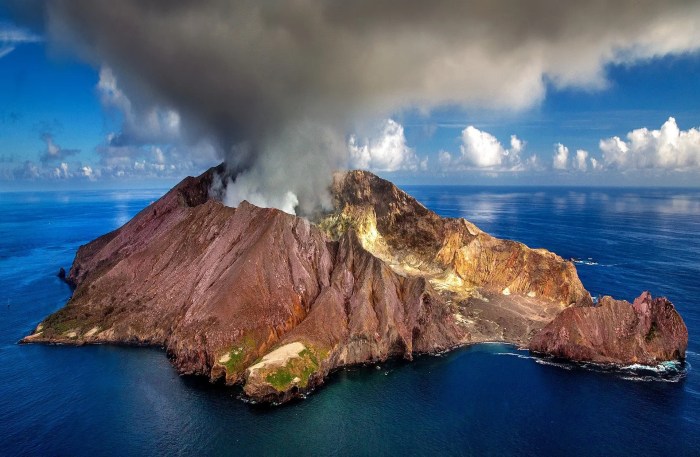
To mitigate and manage volcanic risks, several strategies have been developed, including monitoring and early warning systems, land-use planning, and evacuation procedures. Technological advancements also play a significant role in reducing volcanic hazards.
Monitoring and Early Warning Systems
Monitoring volcanic activity is crucial for timely detection and response to potential eruptions. Various technologies, such as seismic monitoring, ground deformation measurements, and gas monitoring, are used to track changes in volcanic activity. Early warning systems, based on real-time data analysis, provide alerts and warnings to authorities and communities, allowing them to take necessary precautions.
Land-Use Planning and Evacuation Procedures
Land-use planning around volcanoes involves identifying and zoning areas at risk from volcanic hazards. This includes restricting development in high-risk zones and establishing evacuation routes and procedures. Evacuation plans Artikel the actions to be taken by communities in the event of an eruption, including designated evacuation centers and routes.
Technology for Mitigation, Pros and cons of volcanoes
Technology offers innovative approaches to mitigate volcanic hazards. Thermal imaging can detect changes in surface temperatures, indicating potential volcanic activity. Satellite imagery provides real-time monitoring of volcanic plumes and ash clouds. Advanced modeling techniques help predict the behavior and trajectory of volcanic eruptions, aiding in risk assessment and evacuation planning.
Conclusion
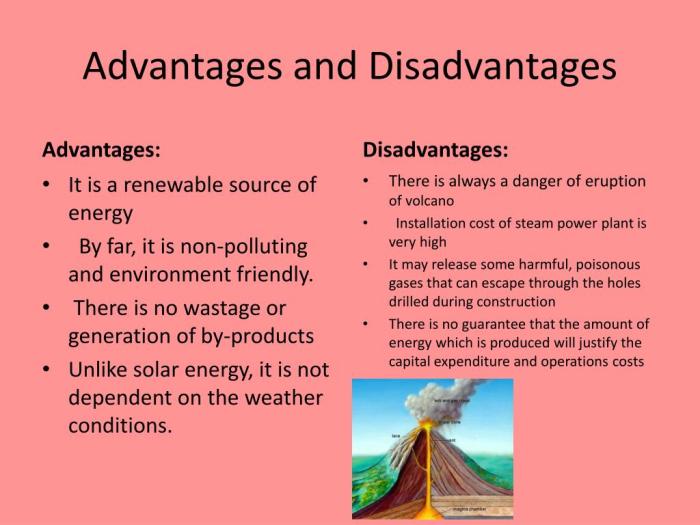
Volcanoes, with their dual nature, present both opportunities and challenges. Understanding the benefits they offer, such as fertile soils, geothermal energy, and tourism revenue, is crucial. However, it is equally important to recognize the risks associated with volcanic eruptions, including property damage, loss of life, and environmental disruption.Striking
a balance between harnessing the benefits and mitigating the risks of volcanoes requires comprehensive research and collaborative efforts. By studying volcanic processes, monitoring activity, and developing early warning systems, we can enhance our preparedness and reduce the potential impacts of eruptions.Further
areas of research could explore innovative technologies for volcanic hazard assessment, sustainable land use planning in volcanic regions, and effective disaster response strategies. By deepening our understanding and working together, we can harness the benefits of volcanoes while minimizing their risks, ensuring a harmonious coexistence with these geological wonders.
Question Bank
What causes volcanic eruptions?
Volcanic eruptions occur when molten rock (magma) rises to the Earth’s surface and erupts through a vent or fissure.
Can volcanic eruptions be predicted?
While volcanic eruptions cannot be predicted with certainty, scientists use various monitoring techniques to assess volcanic activity and provide early warnings.
What are the benefits of volcanic eruptions?
Volcanic eruptions can create new landmasses, release nutrients into the soil, and provide geothermal energy.
What are the drawbacks of volcanic eruptions?
Volcanic eruptions can cause lava flows, ash clouds, and pyroclastic flows, leading to widespread destruction and loss of life.
